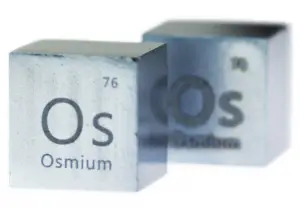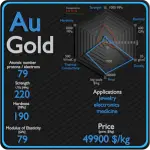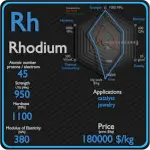This article contains comparison of key thermal and atomic properties of osmium and iridium, two comparable chemical elements from the periodic table. It also contains basic descriptions and applications of both elements. Osmium vs Iridium.

Osmium and Iridium – About Elements


Source: www.luciteria.com
Osmium and Iridium – Applications
Osmium
Due to its rarity and hence expense, osmium has only a few industrial uses. It is used to produce very hard alloys for fountain pen tips, instrument pivots, needles and electrical contacts. It is also used in the chemical industry as a catalyst. Finely divided osmium metal can be used as a catalyst e.g. in the process of forming ammonia by combining hydrogen and nitrogen.
Iridium
Iridium is mainly consumed by the automotive, electronic, and chemical industries. Iridium metal is employed when high corrosion resistance at high temperatures is needed, as in high-performance spark plugs, crucibles for recrystallization of semiconductors at high temperatures, and electrodes for the production of chlorine in the chloralkali process. The demand for iridium surged from 2.5 tonnes in 2009 to 10.4 tonnes in 2010, mostly because of electronics-related applications that saw a rise from 0.2 to 6 tonnes – iridium crucibles are commonly used for growing large high-quality single crystals, demand for which has increased sharply.
Osmium and Iridium – Comparison in Table
| Element | Osmium | Iridium |
| Density | 22.61 g/cm3 | 22.65 g/cm3 |
| Ultimate Tensile Strength | 1000 MPa | 2000 MPa |
| Yield Strength | N/A | N/A |
| Young’s Modulus of Elasticity | N/A | 528 GPa |
| Mohs Scale | 7 | 6.25 |
| Brinell Hardness | 3900 MPa | 1670 MPa |
| Vickers Hardness | 4140 MPa | 1760 MPa |
| Melting Point | 3045 °C | 2410 °C |
| Boiling Point | 5030 °C | 4130 °C |
| Thermal Conductivity | 88 W/mK | 150 W/mK |
| Thermal Expansion Coefficient | 5.1 µm/mK | 6.4 µm/mK |
| Specific Heat | 0.13 J/g K | 0.13 J/g K |
| Heat of Fusion | 31.8 kJ/mol | 26.1 kJ/mol |
| Heat of Vaporization | 746 kJ/mol | 604 kJ/mol |





